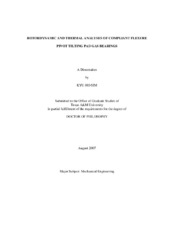| dc.description.abstract | Rotordynamic and thermal analyses of compliant flexure pivot tilting pad gas bearings were performed. First, compliant flexure pivot tilting pad gas bearings with pad radial compliance (CFTPBs) were introduced and designed for high-speed oil-free micro turbomachinery. The pad radial compliance was for accommodation of large rotor growth at high speeds. Parametric studies on pivot offset, preload, and tilting stiffness were performed using non-linear orbit simulations and coast-down simulations for an optimum design. Second, coast-down tests for imbalance response and stability of typical rotor-bearing system with a rigid rotor and two CFTPBs designed from the above design studies were conducted over operating speeds up to 55 krpm. Prediction of synchronous rotordynamic responses was made in terms of critical speed for various imbalance modes by using a rotordynamic analysis software (XLTRC), combined with dynamic force coefficients from the perturbation analysis. For stability analyses, a generalized orbit simulation program was developed considering both the translational and angular rotor motions with two different bearings. Linear stability analyses for the conical vibration mode were also performed by using XLTRC and the perturbation analysis based on the Lund method. Predictions of whirl speed showed good agreement to the tests, but the estimated onset speed of instability appeared lower than the measured instability. Finally, a new thermo-hydrodynamic analysis model of a typical rotor-bearing system with CFTPBs was presented, accompanying linear perturbation analyses to investigate thermal effects on the rotordynamic performance. A numerical procedure was established for solving the generalized Reynolds equation, the 3-D energy equation, and the associated boundary conditions at the pad inlet flow and solid walls (rotor and pad) simultaneously. Parametric studies were conducted on nominal clearance and external load. Nominal clearance showed significant influence on temperature fields, and external load had uneven thermal effects among pads. Case studies with heat flux and temperature boundary conditions on the rotor end surface were performed to simulate various working conditions of the bearing. Large rotor thermal growth due to the high rotor temperature showed noticeable influence on rotordynamic performance by increasing direct stiffness and damping coefficients. | en |


